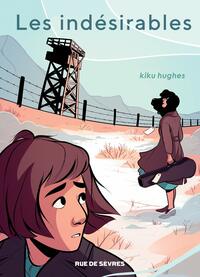You need to sign in or sign up before continuing.
Take a photo of a barcode or cover
emotional
hopeful
informative
medium-paced
Une lecture très éclairante sur l'internement des personnes d'origine japonaise aux Etats-Unis dans les années 40. C'est seulement la deuxième fois que je vois ce sujet abordé dans une œuvre et je recommande vivement cette lecture à celleux à qui ça ne parlerait pas. La BD, semi-autobiographique, s'appuie sur l'expérience de la propre grand-mère de l'autrice-illustratrice. Elle est informative sans que son ton soit trop lourd et la narration suffisamment prenante pour ne pas en faire une "bd documentaire".
J'ai beaucoup aimé comment la narratrice relie l'expérience traumatique de sa famille aux discours de Trump précédent son élection, et sa façon de mettre en avant l'importance du devoir de mémoire et la continuité des luttes anti-racistes.
J'ai beaucoup aimé comment la narratrice relie l'expérience traumatique de sa famille aux discours de Trump précédent son élection, et sa façon de mettre en avant l'importance du devoir de mémoire et la continuité des luttes anti-racistes.
challenging
emotional
informative
reflective
sad
tense
medium-paced
Plot or Character Driven:
A mix
Strong character development:
Complicated
Loveable characters:
Yes
Diverse cast of characters:
Yes
Flaws of characters a main focus:
No
So beautiful! I love the graphic, the story and most of all the melancholic vibe of this novel. I saw this book in a wrapped up video of my favorite booktuber and the moment she said "it's a time travel" I immediately look for the book, so happy it was on KU or else I'd have to wait longer to read it. The time travel is mysterious, what made me stay is the story. Despite the calm and laid back feel of the graphic and the storytelling, I got so infurated a lot and ache for the freedom of the character. I can't say how much I love it, but I am buying the print copy so I can read it again in the future.
adventurous
emotional
informative
reflective
sad
fast-paced
Plot or Character Driven:
Plot
Strong character development:
No
Loveable characters:
Yes
Diverse cast of characters:
Yes
Flaws of characters a main focus:
No
Really powerful graphic novel about the Japanese internment camps. Especially loved the way the author captured what it’s like to learn and empathize with our history. The end had me weeping
challenging
emotional
informative
inspiring
reflective
sad
fast-paced
reflective
sad
fast-paced
I feel as though it’s difficult to rate stories that are so culturally engrained, but it was a really interesting read.
As an educator, I am always looking for YA fiction that exposes students to American historical events that are often not taught or glossed over in school. The history of Japanese internment during World War II is one of them. So, I was glad to find the new graphic novel Displacement by Kiku Hughes. Hughes uses inspiration from her own life to tell the story of sixteen-year-old Kiku who travels back in time to experience life in a Japanese internment camp—the same camp her grandmother is in. The story begins when during a vacation in San Francisco when Kiku and her mother go on a search in Japantown to find her late grandmother’s childhood home. It is here that Kiku feels disconnected from her Japanese heritage, as well as comes to the realization that she doesn’t know much about her grandmother’s experience during World War II. As a result, Kiku has a series of episodes that cause her to time travel, which she calls displacements. One of those displacements sets her in 1943 at the Tanforan Assembly Center. Thus begins her journey. Displacement gives a good account of the internment of Japanese Americans with an emotional story that illustrates the conditions and treatment they endured, as well as demonstrates their resilience and rebellion. Hughes, also through the novel, helps enlighten readers on the impact the historical event had on future generations. As Kiku is experiencing life in the camps, she begins to understand why many of the Japanese traditions and language were not passed down and why there was a reluctance to talk about the pain of being interred. The author also uses the story to show how history can repeat itself when it is lost. She does this by intertwining in the story the recent detention of immigrant children at U.S. facilities. These facilities happen to be the same internment camps that housed Japanese Americans. Overall, I was pleased with Displacement and believes it is a worthy book to add to the reading list to young and older readers alike.






